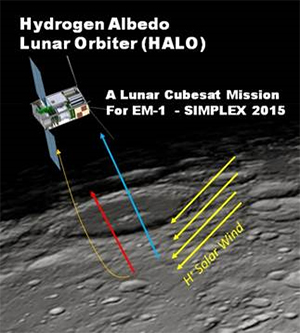HALO: Hydrogen Albedo Lunar Orbiter

HALO will investigate the mechanisms and dynamics of lunar hydrogen implantation. The Moon breathes hydrogen; solar wind protons and micro-meteoroids deliver hydrogen to the lunar surface at local rates that depend on surface composition, local topography, and the presence of structures such as magnetic anomalies. The impinging hydrogen directly affects the surface by weakening the solid state structure as it creates defects in the lattice and by space-weathering the surface. While the reflected proton component affects the electrodynamics around the Moon, for example, by populating the wake region behind the Moon, the implanted hydrogen escapes the surface and forms the hydrogen exosphere through a variety of processes including sputtering, recoil, photon-stimulated desorption, and electron-stimulated desorption. Meanwhile, some hydrogen is lost through deposition into cold traps and the formation of OH, and possibly water, through chemical alteration of oxygen-bearing minerals; in addition, some exospheric hydrogen is reclaimed by the solar wind as picked-up photoions and charge-exchange products. The exact pathway for each of these processes remains unknown, especially at regional scales, and quantifying each of these processes in this lunar hydrogen cycle as a function of solar zenith angle and plasma and space environment will lead to a unified understanding of the plasma, exospheric, and geologic Moon. Furthermore, these are fundamental processes that determine the transport and production of volatiles, including water, throughout the solar system.
Recent News
- On September 26th, the 2nd Planetary CubeSat Science Symposium was held at NASA GSFC, attended by over 100 scientists and engineers. Three sessions of oral talks covered: flight opportunities and programmatics; mission concepts; and hardware systems including buses, propulsion, communications and instrumentation. There was lively Q&A periods at the end of each session, and an afternoon poster session that gave mission proposers the opportunity to meet with vendors and suppliers. Presentations and posters have now been posted.
- Registration for the 2nd Planetary CubeSat Science Symposium, September 26, 2017, is now closed.
Upcoming events
- Small Sat Symposium, Silicon Valley, Feb 5-7, 2018
- All events


